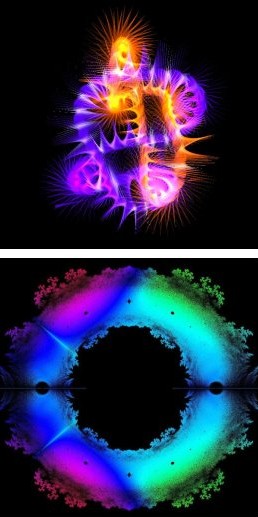IRMACS Centre's Visualization Support

The human visual system is the most effective mechanism for processing complex visual information, and therefore visualization is one of the most effective tools for understanding large and complex scientific data sets. Because the data sets that are being generated by today's scientific devices and computational simulations are increasing in size and complexity, visualization is becoming more and more important in the scientific process.
The goal of the IRMACS visualization infratructure is to provide effective mechanisms for IRMACS researchers to interactively explore complex data sets. The ultimate goal is to not only provide the capability to visualize their data, but to also provide the ability to interactively steer computational simulations and/or to explore data sets and simulations collaboratively with distant colleagues through visualization.
To this end, IRMACS has deployed a set of visualization technologies within the IRMACS Centre. There are two main technological components to this deployment - a set of advanced visualization display technologies and the ability to perform advanced visualization at the researcher's desktop.
Visualization Displays
One of the key components of visualization is of course seeing the data. For many visualization tasks, the traditional display on a researcher's desktop is adequate. Some visualizations, especially those involving large and complex data sets, require a more sophisticated display environment than the simple desktop display.
Visualization in the Presentation Studio (Room ASB 10900)
IRMACS has created an advanced visualization capability as part of the Presentation Studio. This environment is targeted at the presentation of complex data to large audiences. The visualization component of the Presentation Studio consists of a pair of high resolution projectors that are capable of displaying stereo images. The computer creates a stereo pair (a left eye and right image alternately) and the user wears active stereo LCD glasses so that the left eye sees only the left eye image and the right eye sees only the right eye image. Similar in many ways to the technology used in 3D IMAX films, this leaves the user with the perception that the 3D objects are floating in front of and/or behind the screen. Unlike a 3D IMAX film, which is the playback of static, pre-recorded 3D content, the 3D content that is displayed in the Presentation Studio is generated in real time, supporting the scientific discovery process by allowing the user to explore large, complex data sets interactively.
This visualization display in the Presentation Studio is driven by a high end visualization computer with an nVidia Quadro class graphics card. This machine has a wide range of visualization software installed on it, and is available for use to all IRMACS researchers.
Visualization in the Visualization Lab (Room ASB 10912)
IRMACS, in collaboration with WestGrid, has also created a visualization lab for researchers at SFU. This lab is targeted at those users who require visualization at a scale that is beyond what they can achieve on their own desktop or within their own laboratories but do not require the level of capability provided by the Presentation Studio. The IRMACS visualization lab contains a high-resolution 30" LCD display (Apple Cinema Display at 2560x1600 pixels) for high resolution visualization, a lab-scale immersive 3D visualization system (passive stereo CyViz Viz3D system), and a 3x2 tiled LCD display (3840x2048 pixels). These systems target the day-to-day visualization needs of IRMACS researchers that go beyond desktop visualization.
In addition to providing visualization technologies directly for use by IRMACS users, one of the key goals of this lab is to expose users at SFU to the capabilities of advanced visualization technologies. With recent decreases in cost in display (projectors and LCDs) and graphics hardware, these technologies are no longer exorbitantly expensive and are therefore candidates for deployment in a range of research labs across campus.
IRMACS is happy to work with research groups to explore the use and deployment of these technologies in their labs.
Desktop Visualization
IRMACS provides a wide range of visualization software installed on the desktop systems throughout the lab. These packages include 2D image manipulation and visualization packages, advanced computational packages such as Matlab with extensive visualization capabilities, and sophisticated 3D visualization packages such as Paraview. If researchers have requirements for other software pacakages please contact the IRMACS support team.
Visualization Serving
In addition to working with WestGrid to provide visualization displays for researchers at SFU, IRMACS users also have access to the WestGrid visualization machine as a remote visualization resource. The WestGrid visualization server is a computing resource that provides an advanced visualization capability to the end user's desktop. This allows users to connect to the server and employ its advanced capabilities to render very large data sets interactively from their desktop without having any special visualization hardware on their workstation. The images are sent back to the user's desktop over the network and displayed on the desktop using a lightweight visualization client. The visualization server utilizes the IRMACS gigabit network to deliver interactive visualization to the user's desktop.
For more information on the WestGrid Visualization Server, its hardware and software configuration, and how to use the system, please refer to the WestGrid Visualization Server page.

